Refugia Newsletter #69
Windy places, battery tech, Dutch water management, Iona refugia, and more windy places.
Refugia News
I’m coming to you this week from the Isle of Iona, a site of refugia for many centuries. This is the last leg of our three-week, epic journey visiting sites in Switzerland, the Netherlands, and Scotland. I’m eager to tell you about some of my climate- and refugia-related adventures, but I admit I’m also eager to get home. I’ve learned so much and enjoyed the journey, but I miss my home place. I think that’s a good thing.
The North Beach on the Isle of Iona. Iona is a stunningly beautiful, windy, wild place.
This Week in Climate News
A couple quick news stories before we get into my adventures.
It’s hard to imagine the brutal heat in India. You have probably seen the headlines about the heat wave that has swept across South Asia, with temperatures in Delhi, for example, reaching 122F. People have died, many thousands have become ill. If you have read the opening chapters of Kim Stanley Robinson’s novel Ministry for the Future—which begins with a terrifying heat wave in India—you might feel the shiver of fiction becoming reality. Even when people survive such heat, it’s extremely difficult to function in any normal way. Life comes to a desperate stand-still. Of course, the poorest people suffer the most.
This is the reality of climate change: more extreme events, more often. And more suffering, especially among poor and vulnerable people. Excessive heat will be hitting California and Arizona this week, too. And maybe you read about heat in Mexico that seems to have caused (or partly caused) monkeys to drop from trees. As you know, the headlines about extreme, “unusual,” and record-breaking weather events have become a disheartening drum beat in the news. The need to mitigate, adapt, and build resilience has never felt more urgent.
Speaking of Mexico, what does it mean that Mexico has elected a climate scientist as president? Claudia Sheinbaum, who won by a landslide with 58-60% of the vote, is now Mexico’s first woman president and first Jewish president. She also has a PhD in energy engineering. She was part of the IPCC team in 2007 whose work won the Nobel Prize. Will she help advance the world’s efforts toward transition? According to an article in the New York Times by Somini Sengupta, the answer is hopeful but not entirely clear. Here’s a brief summation:
“Claudia is an environmental scientist and unlike her mentor, AMLO, believes in decarbonization and in boosting renewables,” said Shannon O’Neil, a Mexico specialist at the Council on Foreign Relations, referring to Mr. López Obrador [the current president] by his initials. “But she is also a statist, wanting Mexico’s energy transition to be led and controlled by cash-strapped, state-owned enterprises.”
In other words, the state-owned oil company. As Sengupta notes, it’s impossible to predict what Sheinbaum will do, but it’s interesting that Mexican voters seem so keen to have her as their president.
Next, a quick good news piece on battery tech. China is now operating a large-scale sodium-ion battery storage facility: “The 10 MWh sodium ion battery energy storage station features 210 Ah sodium ion battery cells that can be charged to 90% in 12 minutes, according to the company. The system consists of 22,000 cells.” Sodium-ion batteries do not require lithium, and thus use cheaper, more easily obtained raw materials, avoiding the problems of lithium mining. So seeing this technology reaching operable scale is a good thing. In even better news, a US company, Natron Energy, has just opened the first major North American sodium-ion battery production facility in … Holland, Michigan!
If you would like to geek out on the differences between lithium-ion and sodium-ion battery tech, try this delightfully explanatory video by Dave Borlace of the Just Have a Think YouTube channel.
Deeper Dive: Netherlands Edition
So much sky. That’s the title of a painting by the late Chris Stoffel Overvoorde (Calvin University professor of art until 1997) that I used to walk past many times a day at Calvin University, until the painting was moved to another building (sigh). I thought about that painting often during our travels in the Netherlands. Tooling along the country highways in Zeeland and Friesland, long stretches of pasture and cropland on either side, and so much sky.
Honestly, this could be West Michigan, too. No wonder so many Dutch people emigrated to Michigan—it must have seemed like home.
Also, so much water. The Netherlands has been tussling with the sea for centuries, striving to make the most of low, marshy land, and as a result they are extremely good at water management, both coastal and inland. About 25% of the Netherlands is below sea level, and, as civil engineer and Calvin University colleague Bob Hoeksema observes in a 2007 study, about 65% of the country would be under water at high tide if not for dikes, dunes, and pumps.
We visited two of the major coastal Dutch engineering works, the Delta Works and the Afsluitdijk. These two monster projects represent two approaches to managing the Dutch coast. The Delta Works is a set of two locks, six dams, and five storm surge barriers, devised and built over decades following the Great Flood of 1953. The largest section, the Oosterscheldekering, is 9 km long and was completed in 1986. This barrier allows the sea to pass through normally, but can be closed to prevent storm damage and flooding. I refer you to the excellent recent article by fellow Substacker Sam Matey for a clear explanation. You can drive right across the barrier, stopping along the way on Neeltje Jans—a human-made island—for a little walkabout. We saw lots of birds there, many people walking their dogs, dozens of huge wind turbines, and seals!
Thanks to Sam Matey for finding this great map on Wikipedia. I’ve circled the area of the Delta Works we visited. The bottom “finger” of the Netherlands is Zeeland province, the region where my maternal grandfather was born in a delightful little town called Kapelle, which we also visited.
The gates that open and close on the Oosterscheldekering are truly impressive feats of human ingenuity. Image credit: Rijkswaterstaat/new.abb.com.
Seals (harbor seals?) doing seal-yoga behind the “hook” area on the Neeltje Jans island. Image credit: Josh Bareman.
Ron, me, our adult children and spouses. Note wind turbines in the background. Selfie/ussie credit: Josh Bareman.
In the North, the Afsluitdijk is a 32km-long dike/causeway that connects the provinces of Friesland and North Holland. This project was built between 1927 and 1932, basically to reclaim more land and further manage storm-related flooding. The huge dike actually turned the Zuiderzee into a freshwater lake, the IJsselmeer, and allowed the Dutch to “create” 1650 square km of additional land. Wowza.
Are the Dutch aware that their persistence and ingenuity is a valuable global resource for adapting to climate change? Oh yes. This 2017 New York Times article by Michael Kimmelman describes how the Dutch are adapting to higher sea levels themselves and how they are offering their expertise to others as a business opportunity.
This German Wikipedia image is the clearest I could find to show how the Afsluitdijk created a freshwater sea and the opportunity for land reclamation (new land is shown in green).
All over the Netherlands, both in the quiet, rural areas and in the cities, you see evidence not only of ingenious water management but also of energy transition. There are wind turbines absolutely everywhere. No surprise, as the Dutch have also harnessed wind energy for centuries. I find wind turbines rather graceful and serene—much more aesthetically pleasing than fossil fuel plants, for sure.
As of 2023, the Netherlands makes about half its energy from renewable sources—they are behind some of the world leaders on this score (#25 globally according to lowcarbonpower.org). But they are moving quickly, as the chart below indicates. According to the excellent Amsterdam: A History of the World’s Most Liberal City, by Russell Shorto, the Dutch figured out long ago how to work together on big, public projects. Survival has depended on a kind of democratic, cooperative, sensible, practical, ingenious cultural sensibility—a cultural heritage we could all learn from.
Note the huge increases in renewables since 2019. Source: lowcarbonpower.org
In our Dutch travels, we noticed other indications of sustainability: sheep happily munching under solar panel arrays set up in pastures (agrovoltaics), attention to local food sourcing—especially of dairy products—and of course, bikes. So many bikes! Amsterdam is an absolute riot of bikes. Bikes rule the cities. Pedestrians are second place, cars a distant third. The Dutch have figured out how to transport anything on a bike: small children, dogs, groceries. I even saw a construction worker peddling along with construction materials on his shoulder.
Finally, the conservation spots. We visited the remarkable and controversial Oostvardersplassen, an experiment in re-nativizing created on one of those polders (reclaimed land areas) resulting from the Afsluitdijk project. The idea was to create a bird sanctuary and to keep the area from becoming too woodsy for the birds by introducing cattle and horse species (i.e., grazers) as close to ancient species as possible and then let “nature take its course.” Unfortunately, for various reasons, this didn’t work especially well and the big herbivores were starving, especially during one bad winter. Since 2018, management policies have changed to intervene more and make sure all the species flourish, but the area requires a lot of “intelligent tinkering,” as Aldo Leopold might put it. This 2022 article by Phoebe Weston in The Guardian explains the history of the area (and future plans) very well.
We saw this fellow, one of those heck cattle, from a viewing house meant to allow people to view the wildlife without disturbing them. Note the greylag geese waddling along in the foreground.
During our visit, we were lucky to spot some heck cattle, Konik horses, and many species of birds. My daughter, the enthusiastic birder, was definitely in her happy place.
We also did some good birding in the Lauwersmeer natural area and then out on the island of Ameland, off the Frisian coast. There we rented bikes—Dutch bikes are also awesome pieces of engineering—and met some friendly Frisian horses on our way out to the beach. The beach… felt like home. See photo below.
My son making friends with a very handsome Frisian. Let’s just admit that Frisian horses are the most gorgeous horses of all. I’m not biased, truly: I’m not even Frisian.
The beach on Ameland island. Or is it Lake Michigan?? Hmm…. hard to tell, isn’t it?
We appreciated the number of older people in the Netherlands riding bikes around town or peddling along country bike roads. Or dressed up in their hiking gear, binoculars at the ready, on the trails. Everyone seems to remain physically fit in the Netherlands. They have to!
Refugia Sightings: Netherlands/Iona Edition
While in the Netherlands, we visited a number of excellent museums, including the Fries Museum (it’s about Friesland, not French fries!) and the Verzets Resistance Museum focused on Dutch resistance during World War II. Both were well worth a visit. Among other things, we learned quite a lot about the misery and complexities of World War II in the Netherlands. I could go on about this, but I’ll mention only one little corner of the Fries Museum, where a small exhibit featured a refugia space I found especially moving. Between 1946 and 1953, on the island of Ameland, a particular holiday guest house provided shelter and reprieve to “families who were missing loved ones because they had been killed during their resistance work, or resistance families who were otherwise carrying a heavy burden.” What a beautiful idea—for two weeks, in the wake of so much trauma, these people were cared for and pampered, listened to and comforted.
A recreation of the community area in the Ameland holiday home where resistance families were given reprieve and rest after the war.
And now, Iona. Husband Ron and I traveled the first two legs of our journey with our adult children, but for this last portion of the trip, we are traveling with seven doctoral students from our “refugia church” Doctor of Ministry cohort through Western Theological Seminary. Our destination: the Isle of Iona.
Iona is located off the western coast of Scotland, and it’s quite a pilgrimage to get here: train, ferry, bus, ferry, long walk to our hostel on the north end of the island. Nothing is easy about Iona, but people have long sought refuge here, close to the wildness of the world and close to God.
An Irish abbot, now known as St. Colomba, came here from Ireland in 563 AD with a dozen followers, hoping to form a monastic and scholarly community. That community thrived for several centuries, spreading Christianity (in the Celtic mode) through Scotland and Northern England. Among the many legends about St. Colomba, this one (taken from a placard in the abbey church yard) is my favorite:
“In one story [St. Colomba] performs a proofreading miracle, correctly predicting that there would be no mistakes in a monk’s book, ‘except that in one place the letter I is missing.’”
I did not know there was such a thing as a proofreading miracle, but hey, good to know that’s a possibility.
In the 800s, Viking raids put an end to that first monastic period, but a few centuries later, a group of Benedictine nuns made a go of it, thriving in their refugia community from the 1200s to the 1500s. The “nunnery” is one of my favorite parts of the island. I love thinking about a group of enterprising women-religious managing together here.
Ruins of the “nunnery” on Iona.
The next significant refugia community was founded by Church of Scotland pastor George MacLeod during the Depression in the 1930s. MacLeod wanted to help the many shipworkers and laborers left without work, so he founded a community on the island combining skilled labor (they worked on restoring the abbey buildings), worship, and community support. That Iona Community transitioned eventually into the current Iona Community, an ecumenical Christian peace-and-justice organization, known worldwide, especially for their work on worship resources through the Wild Goose Resource Group.
In 2020, I interviewed current Iona Community Leader Ruth Harvey for the Refugia Podcast. We discussed how the Iona Community is now a sort of lay-religious order of about 270 full members, plus associate members and friends. The members, however, live all over the UK and the world. They are, as we put it in the interview, both “located and dispersed.” While the Iona Community keeps offices in Glasgow and runs programs on Iona and Mull, members are usually dispersed to their home communities. This refugia model has some key advantages. Refugia by definition are not isolated and cut off from the surrounding ecosystems. They are relatively sheltered places where capacities rebuild, but the edges are permeable so that life can spread. So Iona members “seed” their home communities with the life-giving capacities they practice within the Iona community, including on the Isle of Iona—which is not as remote and isolated as one might think, and never has been.
These days, Iona remains an important pilgrimage site. Regular folks do live here year round, and much of the island is “crofted” for sheep and cattle. But it’s still a wild, windy, challenging place, beautiful but sometimes forbidding. Why would so many people choose this little isle as a site for refugia communities? Some say, as George MacLeod did, that it’s “a thin place where only tissue paper separates the material from the spiritual.” Is it? I have asked myself that each of the three times I’ve come here.
This time, I’ve been reflecting that whether or not I feel “the magic” while I’m here is not the point. The world is full of thin places, and this island has proven thin for many people over many centuries. That’s enough for me. Not to say that there haven’t been moments of surprising divine encounter for me and for our students. It helps to stay here for several days, attend worship in the abbey, walk about the island. The Iona Community has created such an important model for a relevant, peace-and-justice-focused, humble, contemplative/active Christian witness. But our group is here primarily to pay respects to a long legacy of faithful refugia. I’m reminded of T. S. Eliot’s poem from the Four Quartets, “Little Gidding,” about a refugia community in Cambridgeshire that meant something to him. Eliot wrote:
If you came this way,
Taking any route, starting from anywhere,
At any time or at any season,
It would always be the same: you would have to put off
Sense and notion. You are not here to verify,
Instruct yourself, or inform curiosity
Or carry report. You are here to kneel
Where prayer has been valid.
The graveyard, with the abbey in the background.
Our group is staying in a large hostel on a sheep croft at the north end of the isle. The green shed just visible is our place.
Puffins! We took a boat trip out to the tiny island of Staffa to visit this puffin colony. Surely, these are the most adorable birds ever to exist.
Snails?
I’ll leave you with the second installation of what is apparently an ongoing series on snails. We’ve seen about a million snails and slugs on our travels in all three countries. This ambitious friend here on Iona spent much of the morning scooting all the way up the door to our little hostel/apartment and then napped at the top in the sunshine for the rest of the day. Apparently, all snails (and slugs!) in Britain are edible, but we declined to test this hypothesis.
Next time, the newsletter will be back to our usual format. Until then, thanks for reading this chonky edition, and be well. Also, if you find any proofreading errors in this newsletter, please pray to St. Colomba for a miracle.
As always, bold type in quotations is added unless indicated.





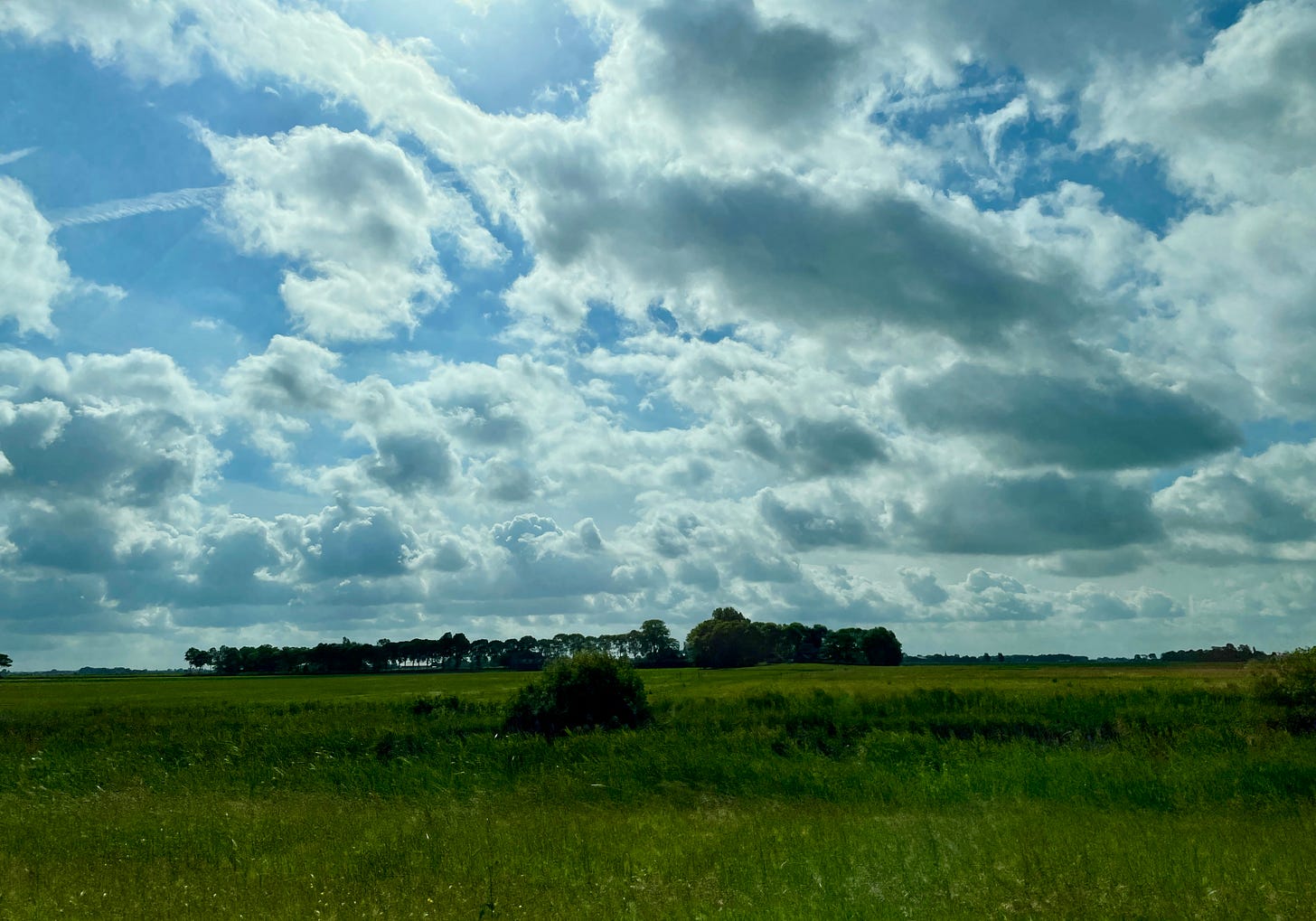


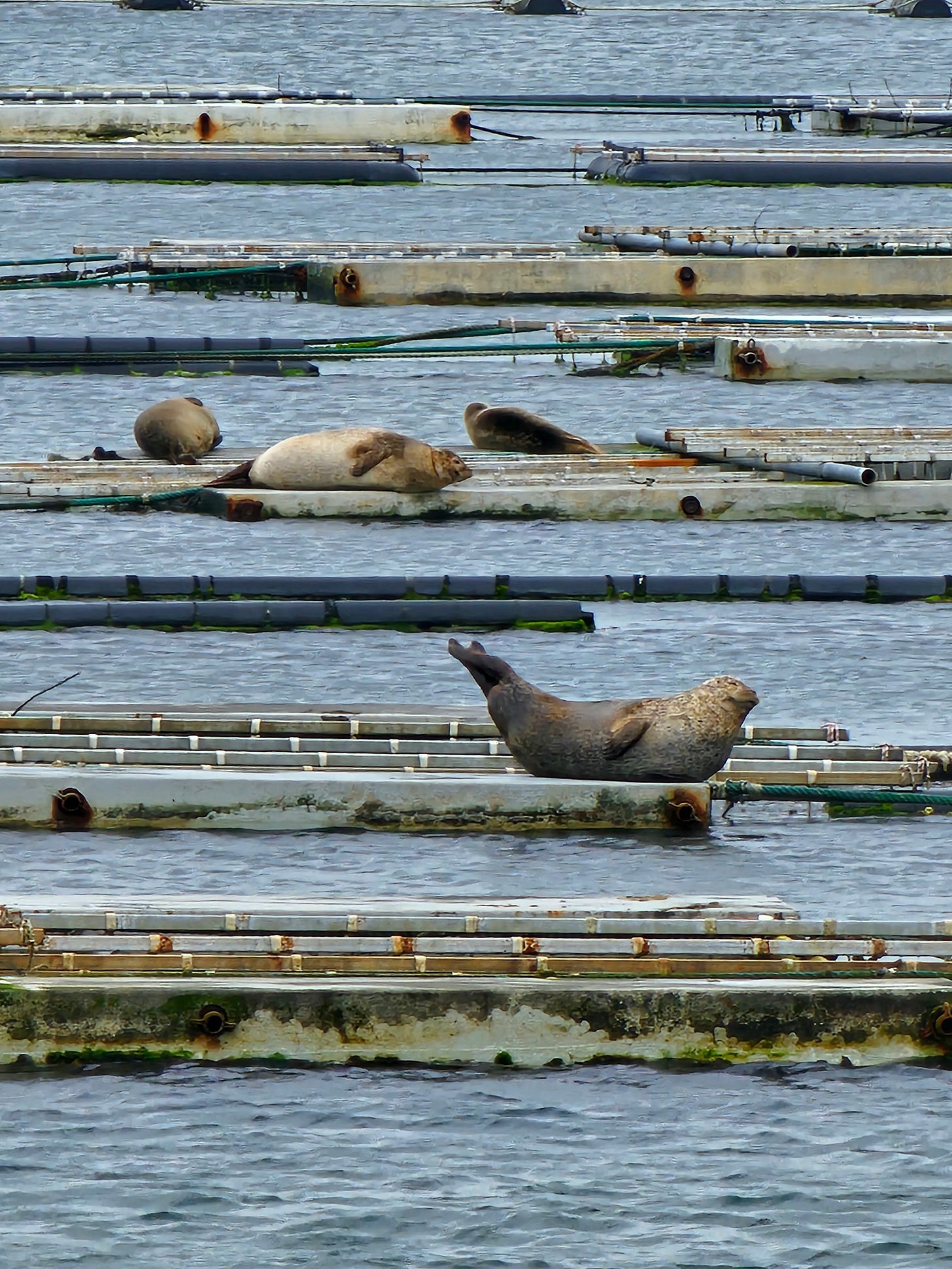
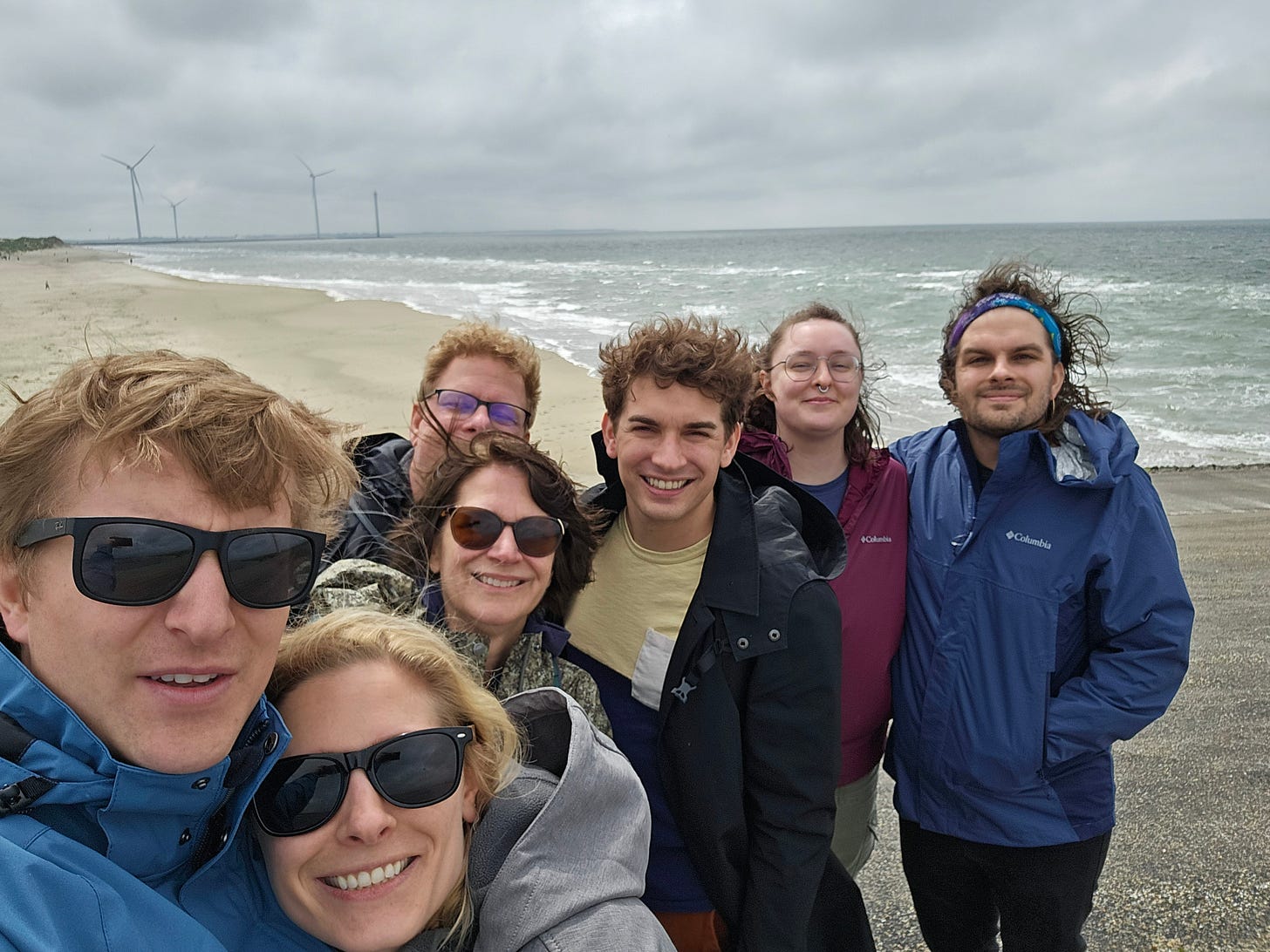


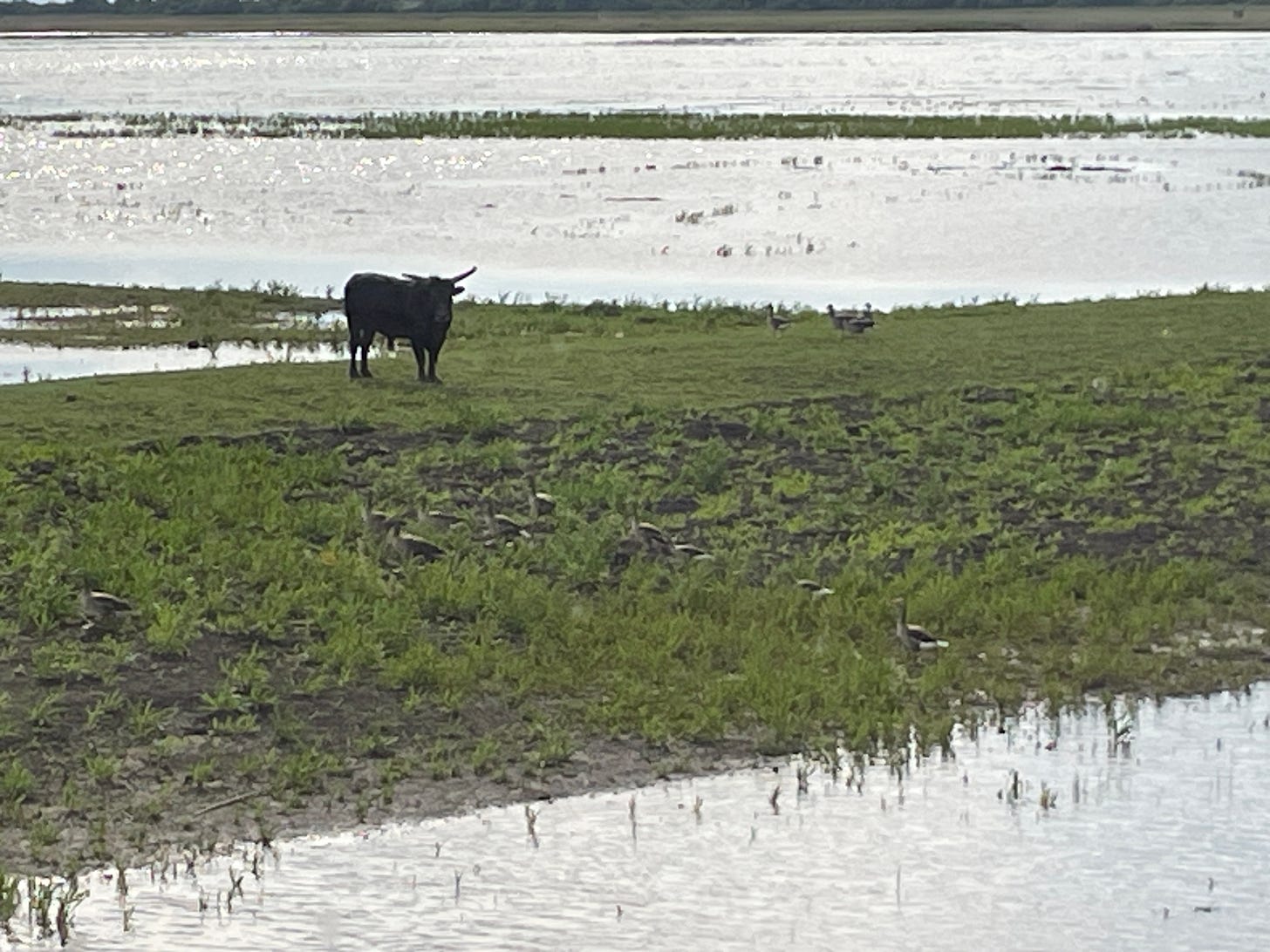

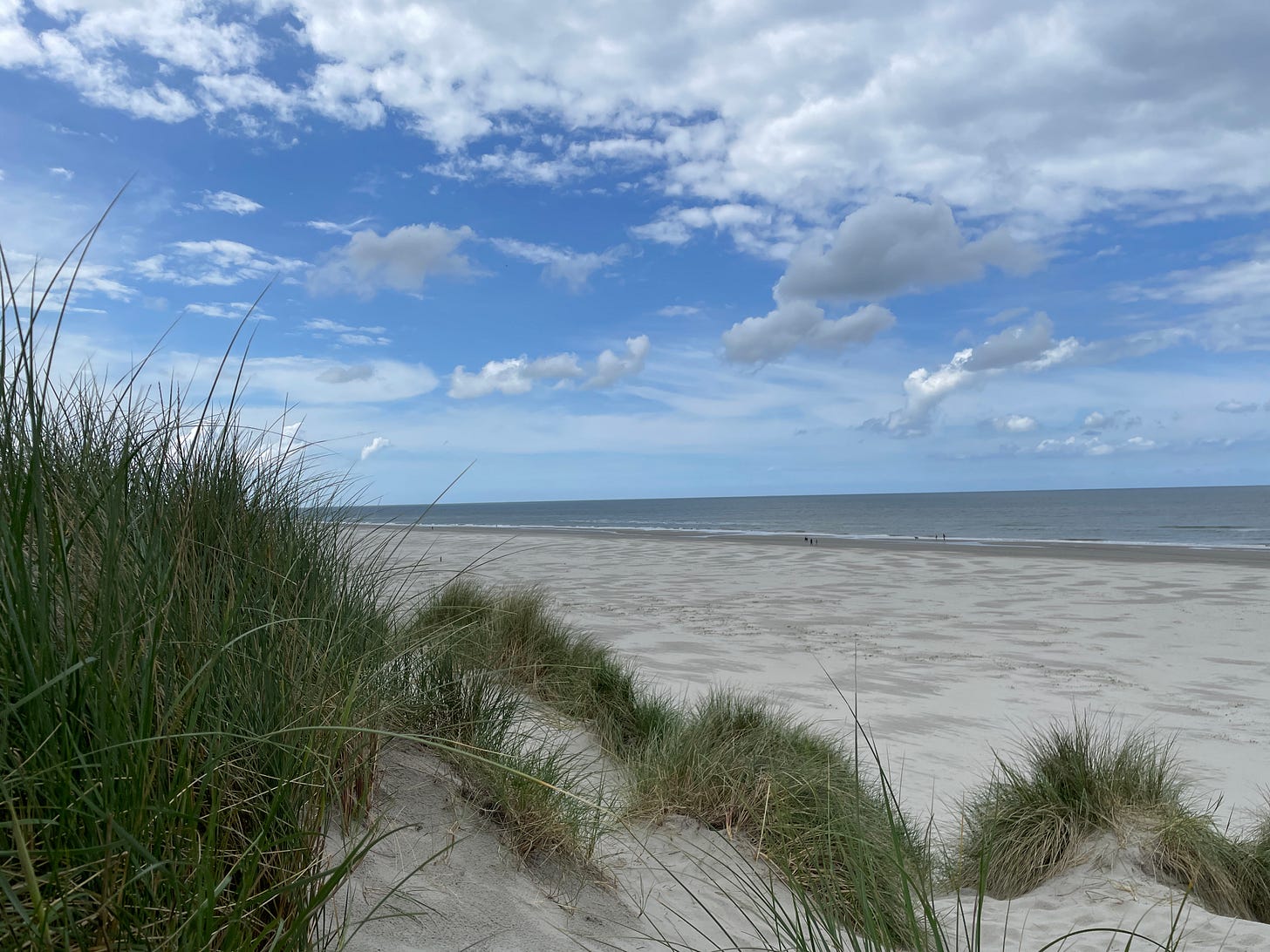





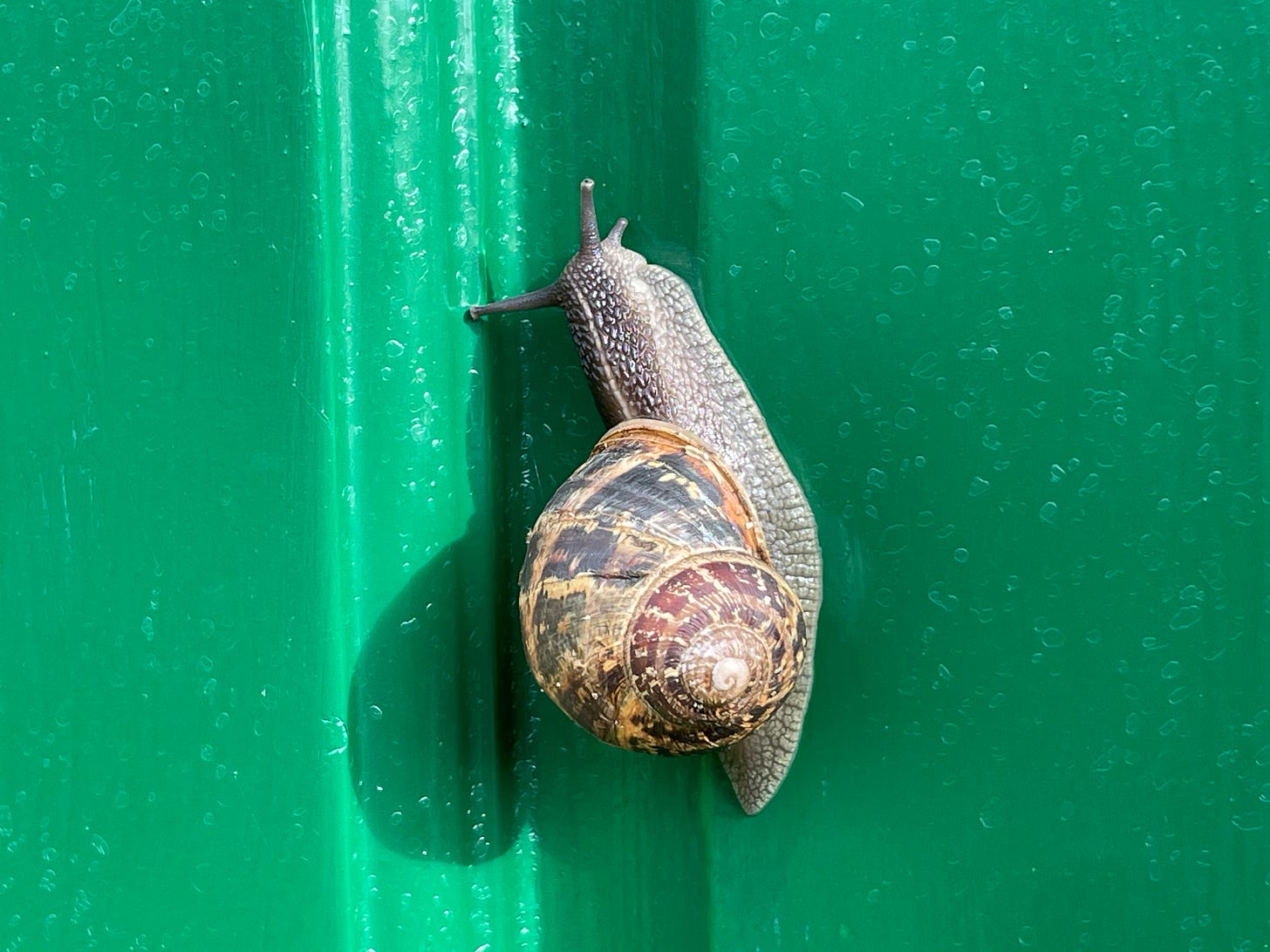
Thanks for sharing your three weeks of engaging explorations! Glad you included a visit to the impressive Fries Museum which includes the sobering Verzets museum!
Thank you for this colourful and insightful travelogue, especially in these turbulent and troubling times. Its encouraging, hopeful, and peaceful, and invites each of us to find or create such experiences for ourselves and others.
John Hiemstra